When Josh and Vanessa’s 1994 Toyota FJ80 Land Cruiser broke down on the side of the highway near Guadalajara, Mexico, the experience affirmed the modifications they had made before departing from their hometown in British Columbia, Canada. Easy access to tool rolls, spare parts, and recovery gear was paramount for Josh, who diagnosed a broken U-joint, which consequently smashed the 80-Series’ drive shaft, cracking the transmission. A sleeping platform in the rear of the Cruiser proved a haven for Vanessa, who was suffering from a stomach bug and needed to rest while the couple waited for help.
Four hours later, and long after dark, a tow arrived. Although not ideal, Josh and Vanessa had been prepared to sleep in their vehicle if necessary—a testament to how they built their 80-Series allowed them to do so. How we organize and bring comfort to our vehicles becomes even more important when we experience challenges on the road. Here are more insights from this Canadian couple, with a look inside their 80-Series Land Cruiser with a Campteq pop-top.
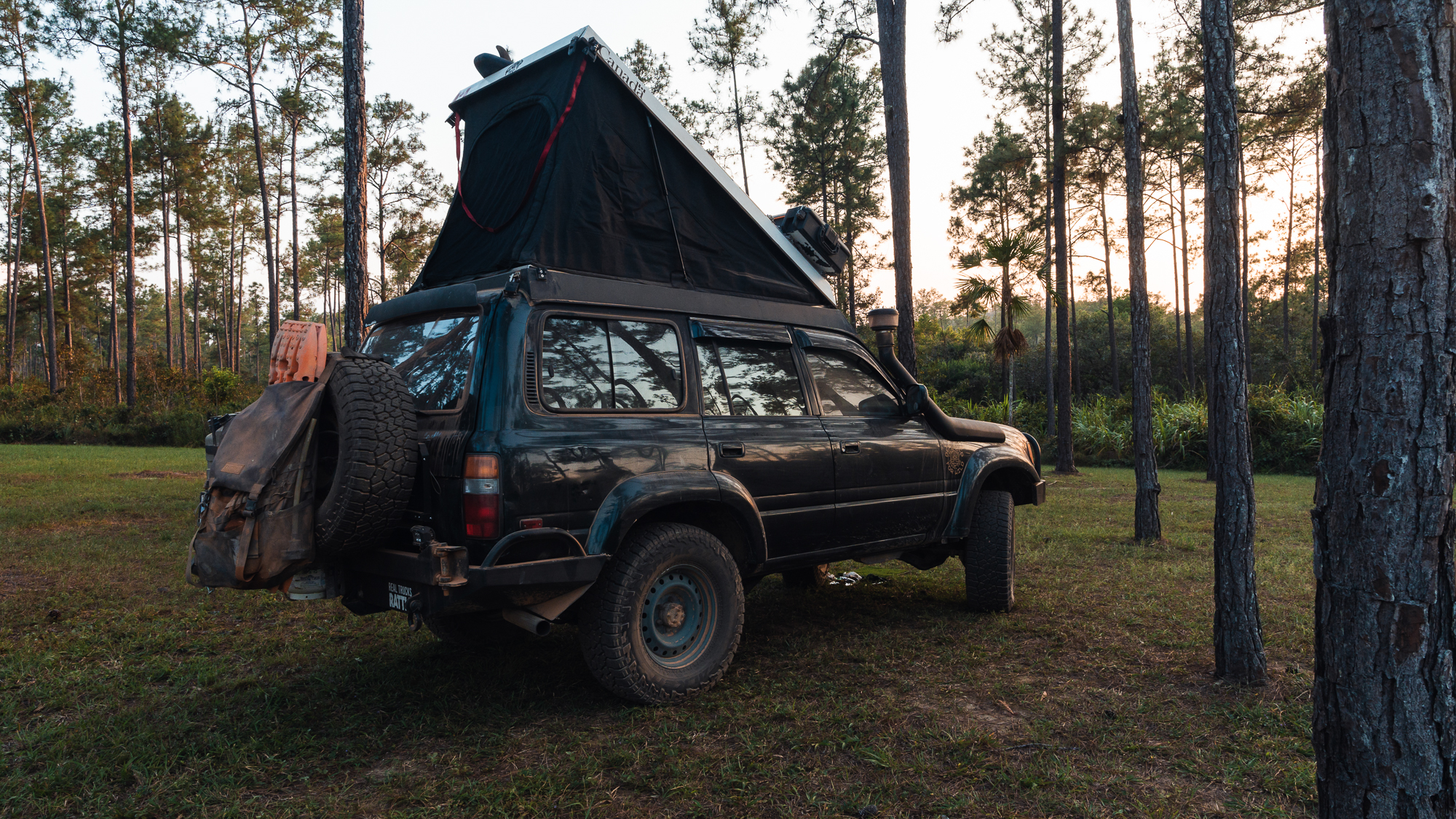
Sleeping Quarters
“While planning for the Pan-American Highway, we originally built our 1992 Mitsubishi Delica L300 as our adventure rig. After finding out that right-hand drive was less widely accepted in a few Central American countries, we decided to search for something different. In our quest for a new vehicle, we knew that we wanted something reliable, simple to fix, and that was capable of going anywhere.
Months into our search for a vehicle, we found our 1994 Toyota FJ80 Land Cruiser. For years it had been a dream of Josh’s to own a Land Cruiser, so it was a bit surreal when we brought the Cruiser home. We had initially looked into a rooftop tent as a way to sleep while travelling; however, having internal livable space was high on our list for the trip.
The next option we looked into was a pop-top roof. A pop-top would allow us to cook, work, stand up inside, and have a place to hang out if the weather isn’t ideal. This was the most ideal option for our needs. We looked into other hard shell pop-tops like Alu-Cab, and even fabricating a pop-top ourselves, but we landed on the Campteq. Since the Campteq is focused on Land Cruisers—specifically the 80-Series—we knew this would be right for us. We admired the simplicity and functionality of the Campteq, and we were inspired by others who had driven the Pan-American with this platform.
In the summer of 2022, we drove to Colorado, where Campteq is based, to get our roof chopped and the top installed on the Land Cruiser. That fall, we got help from Vanessa’s uncle (Kris Crawford of Further North Fabrication) to make our vision for the interior setup come to fruition.
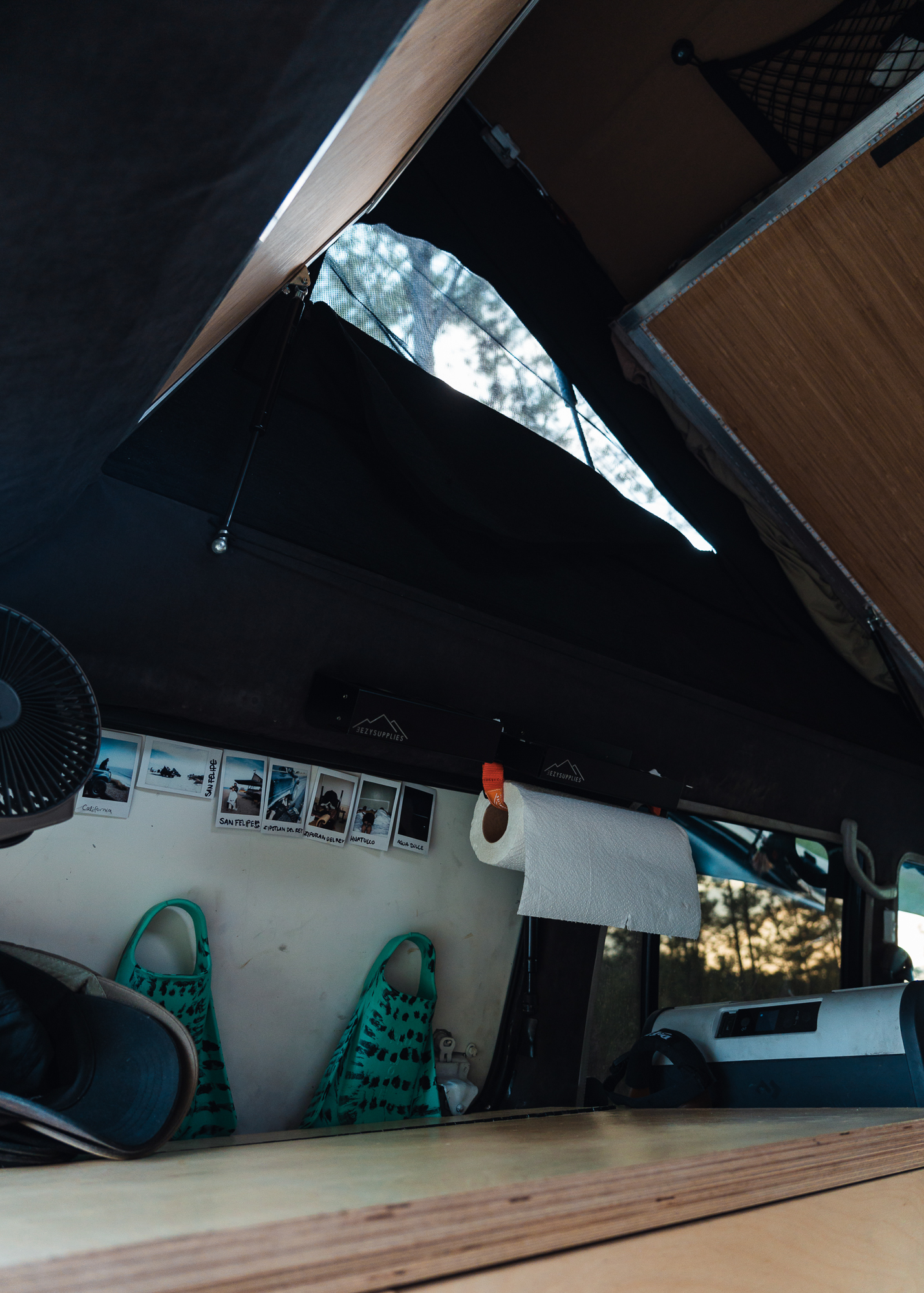

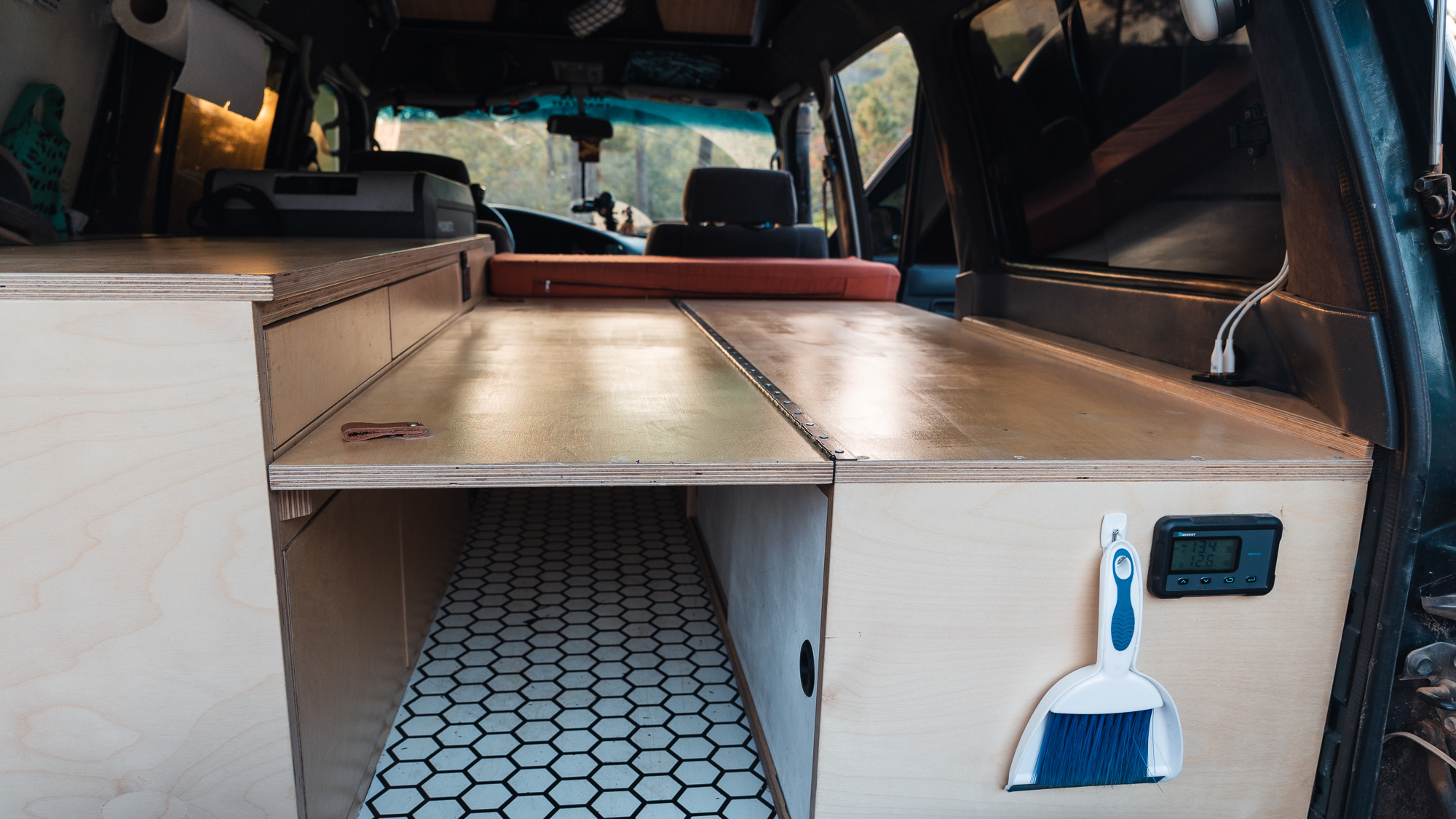
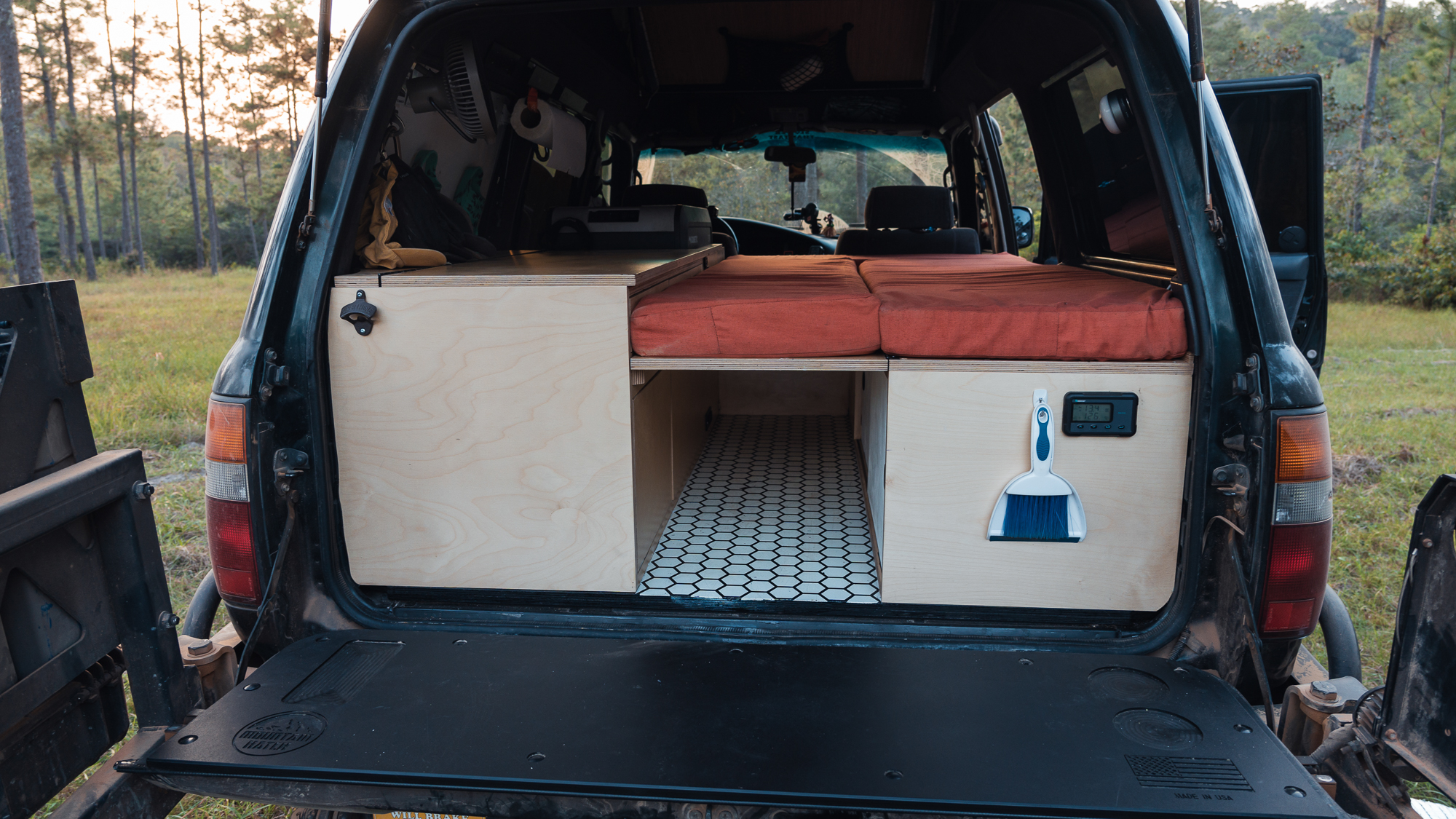
For bedding, we have a few options. When we are in colder climates, we both have down sleeping bags, but when we are in warmer climates, we sleep with a set of sheets and bedding. While the sleeping bags are not in use, they are stored in our Pelican roof box. The bedding we use stays on the bed in the rooftop, so we don’t have to worry about packing it away each day.
Living on the road means we will run into places where we may need to be less conspicuous [while] sleeping in our vehicle. When stealth is needed, we sleep down below on our fold-out bed. This is made up of our bench and a fold-out board that is attached to the top of the bench using a piano hinge. When making the secondary bed, we simply fold over the leaf and place the edge of the board on a strip of wood that supports the board along the side opposite the bench. It’s a bit squishy sleeping on this bed, but it works for times we need to be sneaky about car camping or camping in an area with strong winds.”
Kitchen Items, Food, and Water Storage
“When it comes time to cook our meals, we use a Camp Chef Everest 2X dual burner propane stove. To use the stove, we set it up on a fold-out table on the back of our tire swing-out. After cooking, we put the stove back in its home under the fridge. The main downside of this current setup is we have to use it outside of the Cruiser. Cooking outside is typically a non-issue unless we come across some bad weather or too many mosquitoes.
If we need to cook inside, we use our backup stove, a Jetboil Flash, but we mainly use this to boil water for coffee and heat soup. Our pots and pans are a stainless steel Stanley cookware set that includes four plastic plates, bowls, cutlery, and cooking utensils; it stacks all into the pot, which is a huge win for saving space. Cookware and the Jetboil can be found in the smaller bottom drawer under the counter. All of our kitchen utensils and cutlery are stored in the top left drawer.
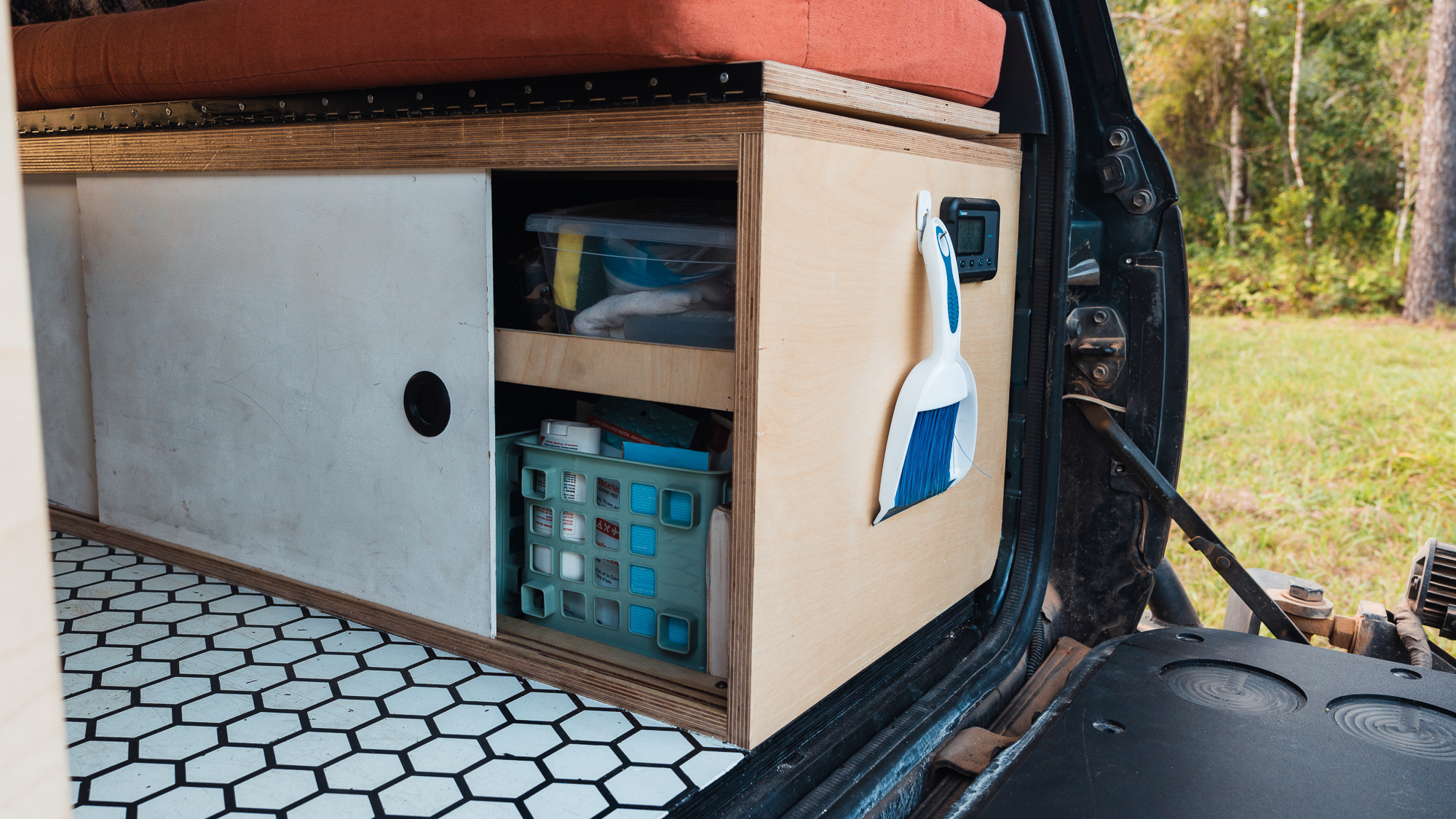
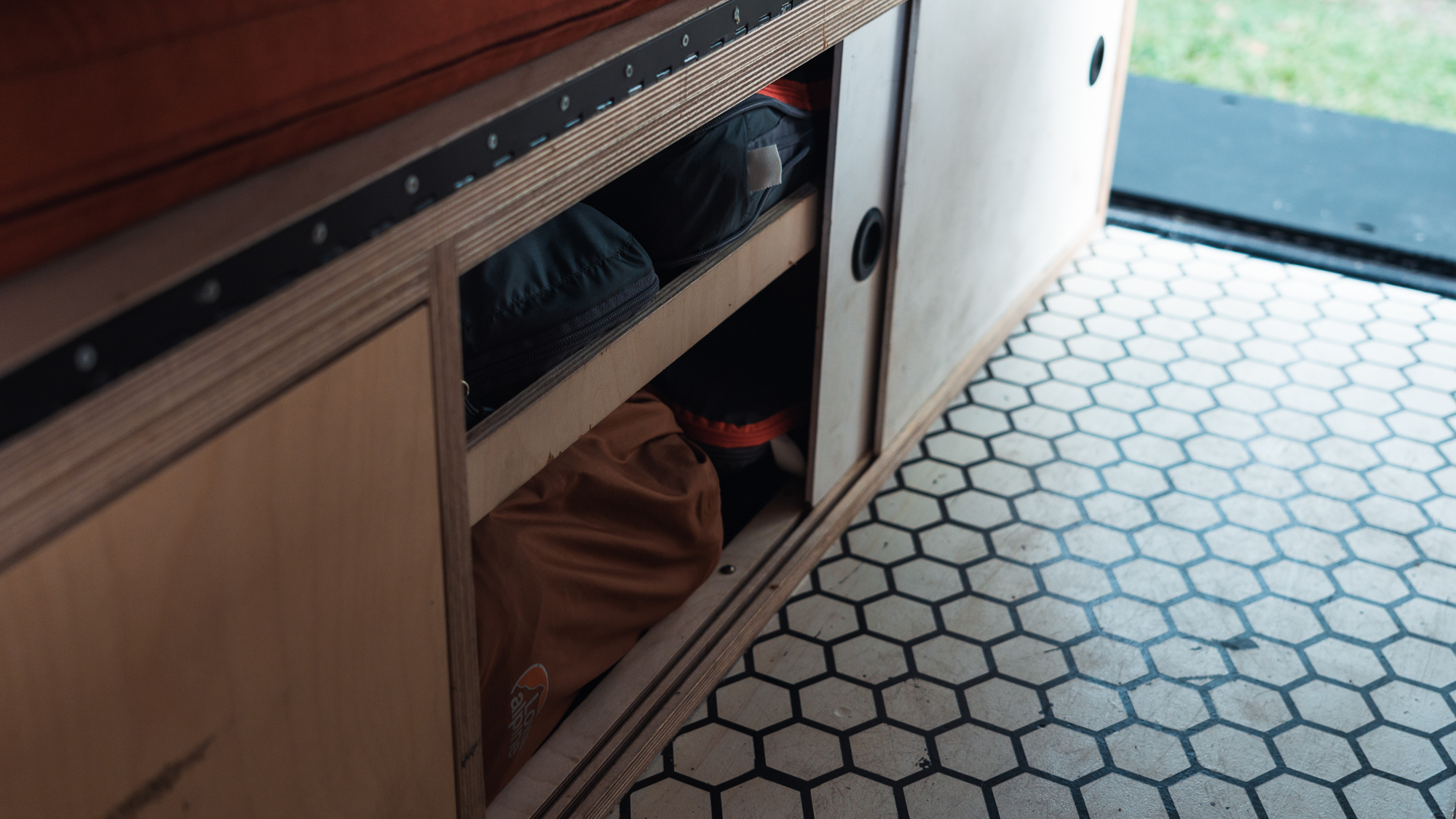

When it’s time to wash dishes, we use a collapsible sink that we store in the top flap of our Trasheroo. This setup works for us as it allows the use of the interior space while food is being cooked off the back kitchen setup. We use the Trasheroo, [which is] attached to the spare tire, to store garbage.
We carry 40 litres of water with us in jerry cans. One is a LifeSaver jerry that can filter our water when needed, while the other is a simple Scepter with a spout added to the bottom so that we can easily access water. Our water jerry cans are stored on the left swing-out of the rear bumper.
All of our dry goods are stored in the larger bottom drawer. In the drawer you’ll find airtight containers for our dry goods like rice, noodles and oats. You’ll find spices in our top right drawer stored in magnetic jars.
Fresh food, condiments, and drinks are kept in our 45-litre Dometic CFX fridge. We also keep a jug of water in the fridge so that it’s nice and cold for hot days; the water in the jerry cans is like lava after sitting in the sun all day, so we transfer it to the water jug to avoid drinking that.”
Camp Life: Table, Chairs, Clothing, and Toiletries
“Our main tabletop is our counter inside the truck that we sit at on our bench. When we want to eat outside, we either use our tailgate or sit at our foldable table with our Helinox chairs. The tailgate is modified to be a worktop for cooking food with our Mountain Hatch cover, but we also sit on it when we want to eat outside and don’t feel like setting up our table and chairs.
The majority of our clothing is stored underneath our bench, behind the sliding doors. Under the bench are two shelves that hold our clothes in compressible packing cubes, including the Osprey 12-litre Straight Jacket bag. Bulkier clothing, like sweaters, sit folded on the shelf beside the packing cubes.
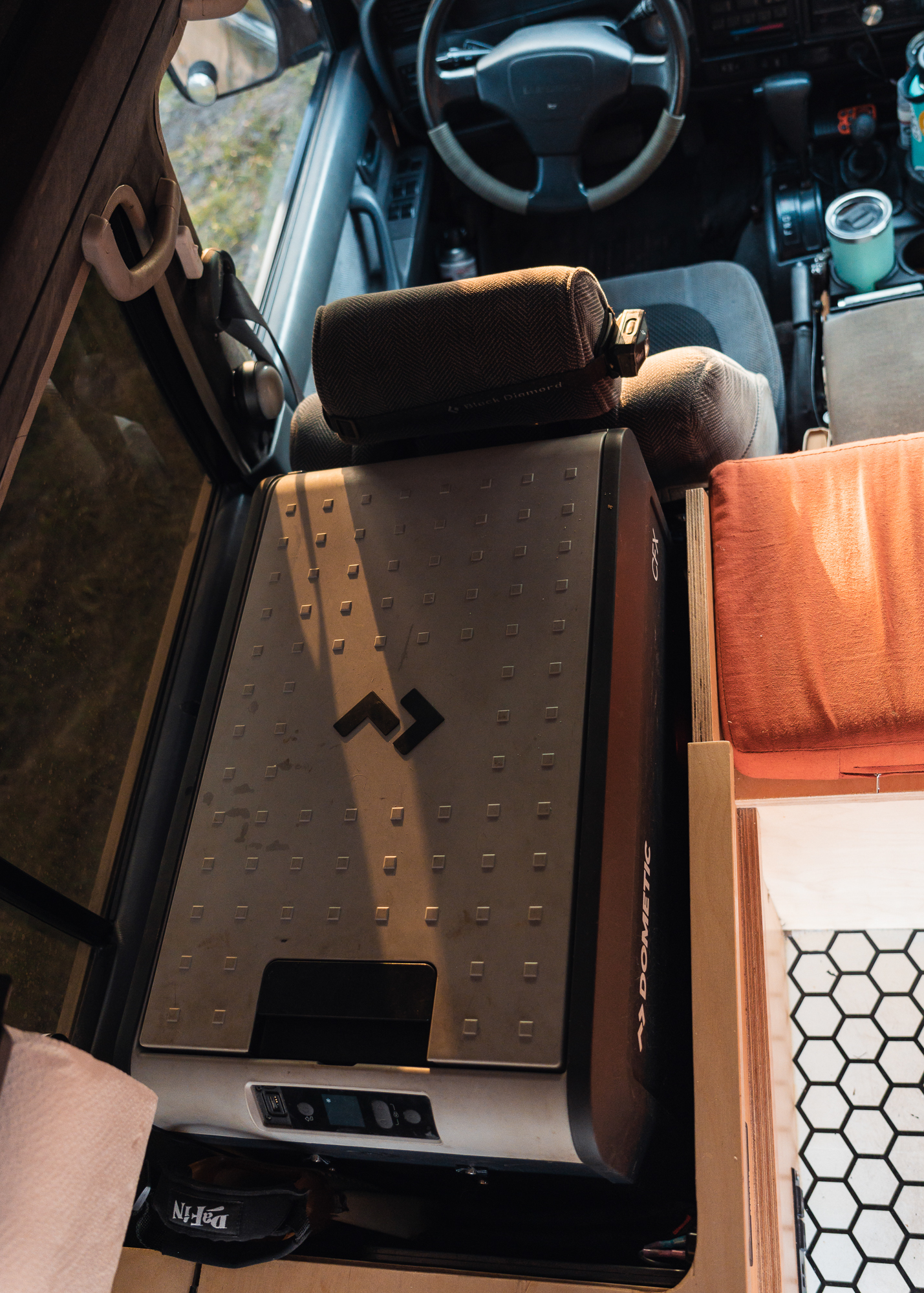

On the rest of the shelves are small baskets that hold our less-used toiletries and small containers that store our extra cables, batteries, medicine, and dishwashing supplies. The most used toiletries are kept in our toiletry bags that are stored in a cabinet under the bench. This cabinet can be accessed either by the rear passenger side door or via a door that opens from the inside of the truck. Besides our toiletry bags, we store other more used items like bug spray, sunscreen, and towels in a basket inside the cabinet.”
Miscellaneous Items: Hiking, Surfing, and Photography Gear
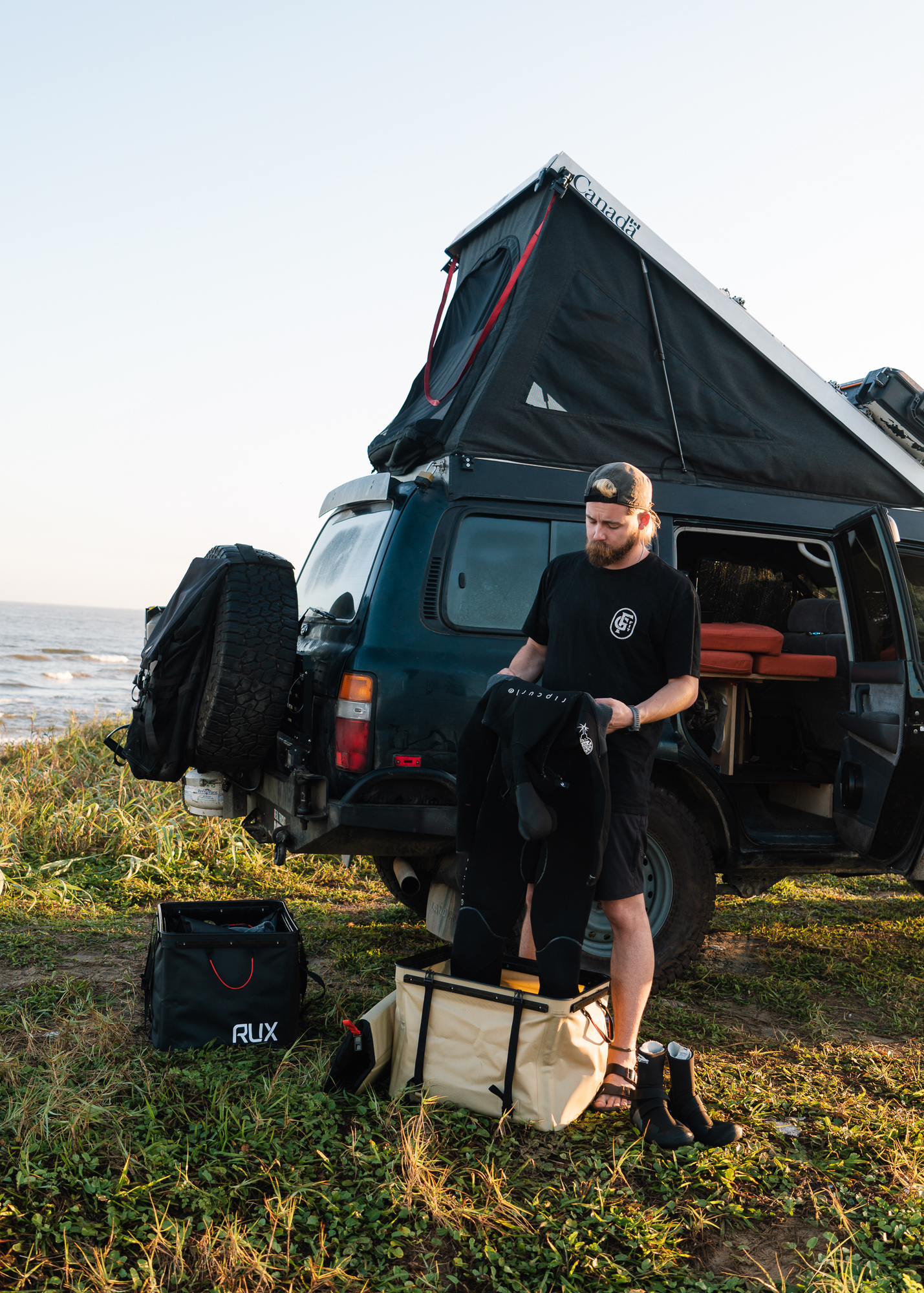

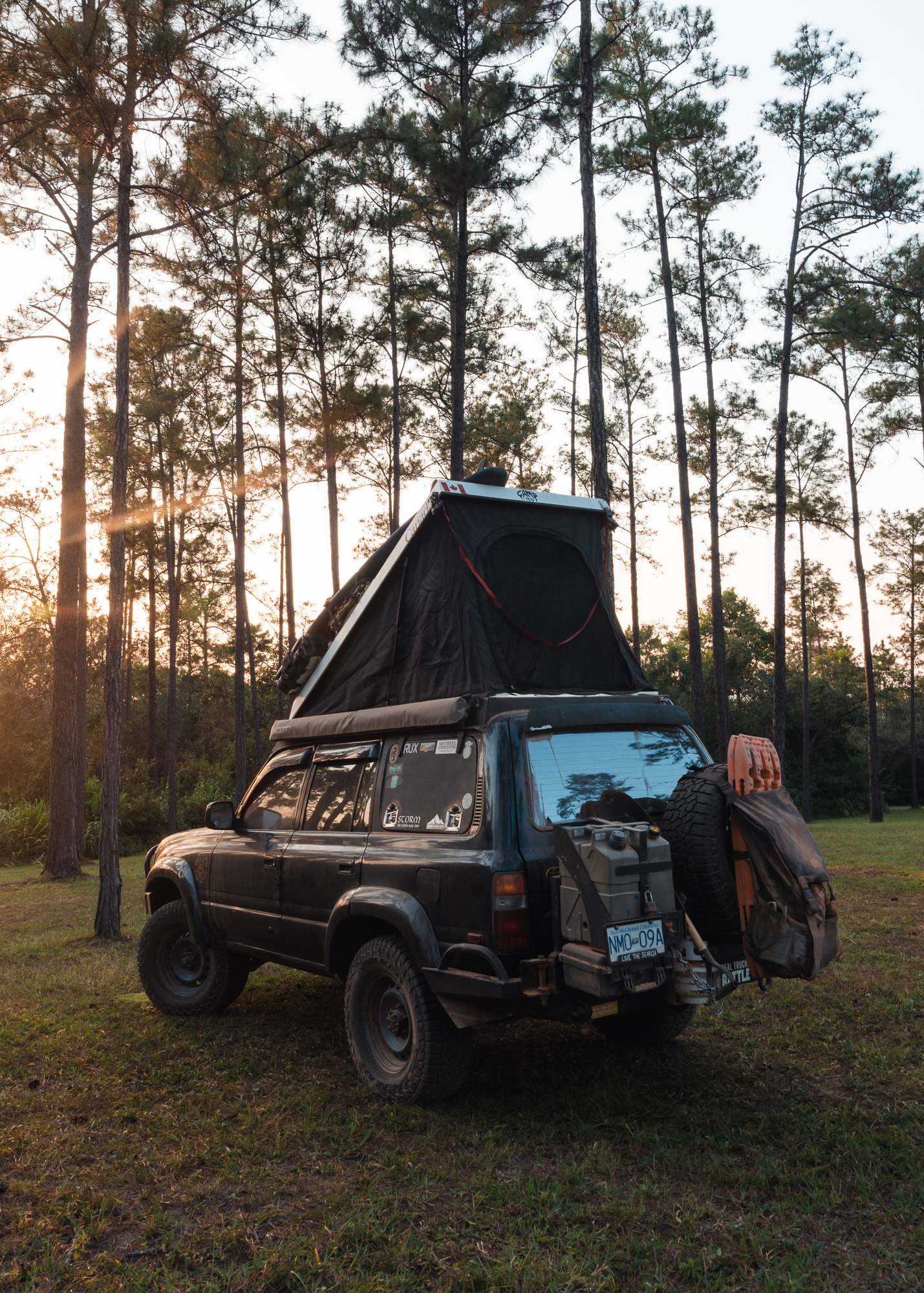
“Our main interests are hiking, surfing, and photography, but that gear can be a little bulky for a small space like our truck, so we had to get creative. Our wetsuits are stashed in a 70-litre Rux that sits snugly under our surfboard, which is also strapped to the roof rails.
We have a Pelican Vault case mounted to the truck’s roof for gear we don’t need immediate access to at all times, like our cold-weather layers, sleeping bags, and dive housing for surf photography. Our snorkels, fins, skateboard, and hiking boots are stored in a cavity between the truck’s interior wall and the back of the drawers. The easiest way to access this cavity is to open our DIY Gullwing and lift a hatch to expose that space beneath it. Rather than leaving it as unused space, we thought to make use of it by stashing odds and ends in that spot.

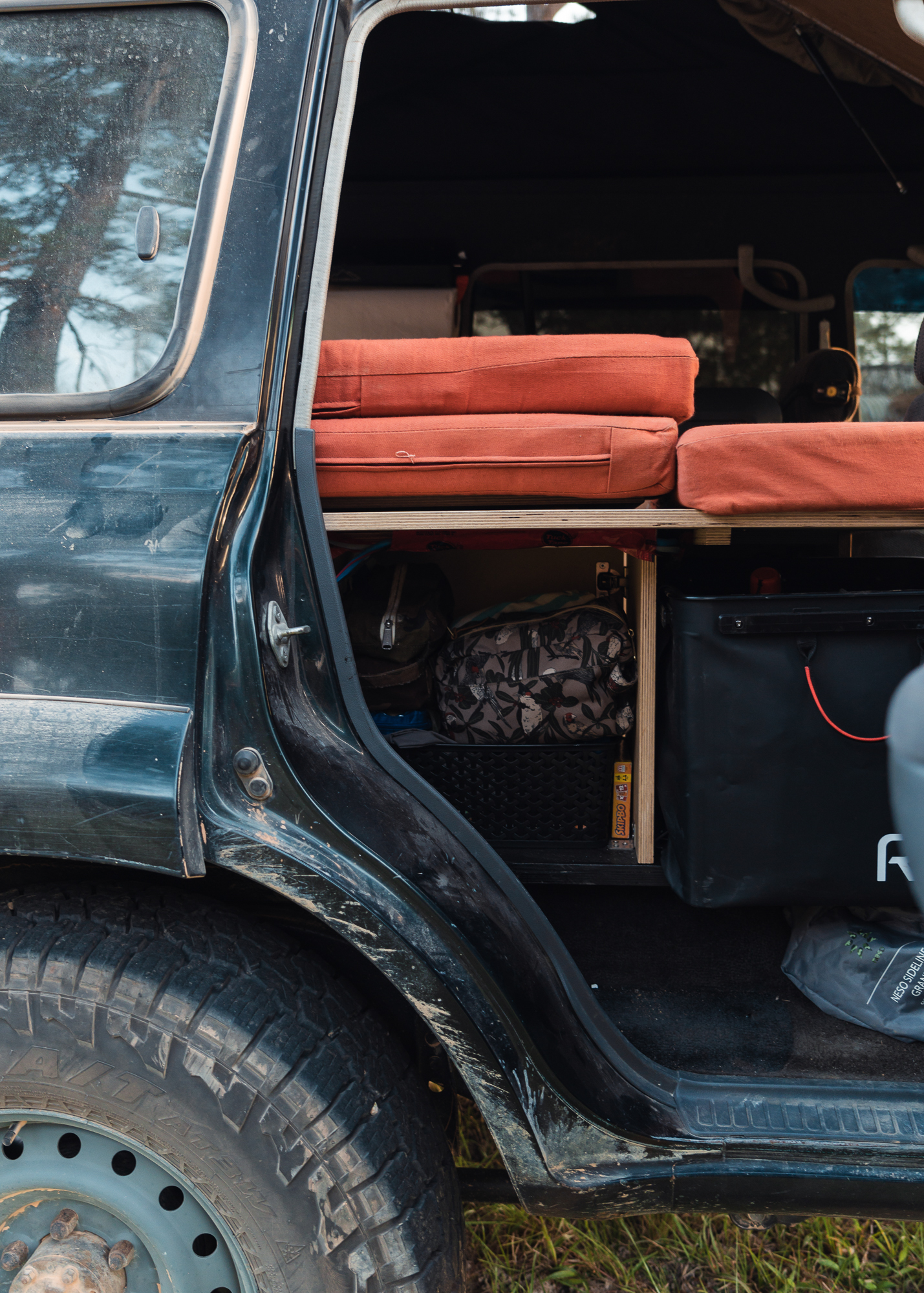
All of our camera gear is stored in a second 70-litre Rux bin stowed behind the passenger seat, allowing easy access to our cameras and the ability to remove the whole bin from the truck when needed.”
Tools, Spare Parts, and Recovery Gear
“We kept our spare parts list simple to cover the basics, as most parts for Land Cruisers aren’t too difficult to find in Central and South America. Before hitting the road, we replaced almost everything that wears down. Just to be safe, we have two sets of new belts, a new set of radiator hoses, several oil and fuel filters, two new fusible links, and enough new fuses to build the truck several times over.
The majority of our spare parts and recovery gear is stored inside our tailgate, which sounds weird, but we repurposed the empty space inside the tailgate [for] storage. We modified the tailgate by cutting a section of the metal open, revealing the inside, and placing our Mountain Hatch over the top to cover the holes. To make this space accessible, we mounted a hinge to the Mountain Hatch as a lid for the cutouts and provide a hidden storage compartment.
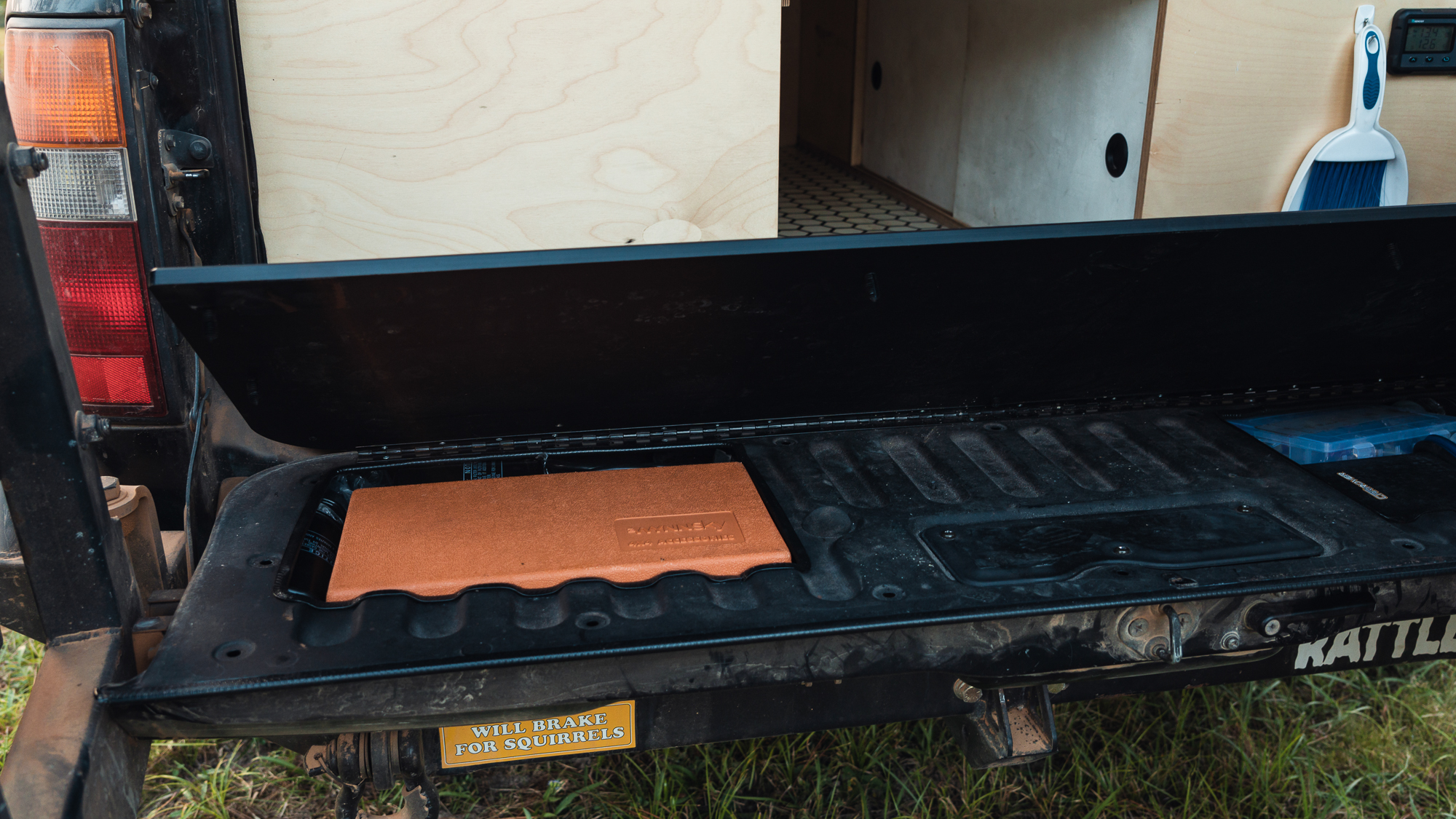
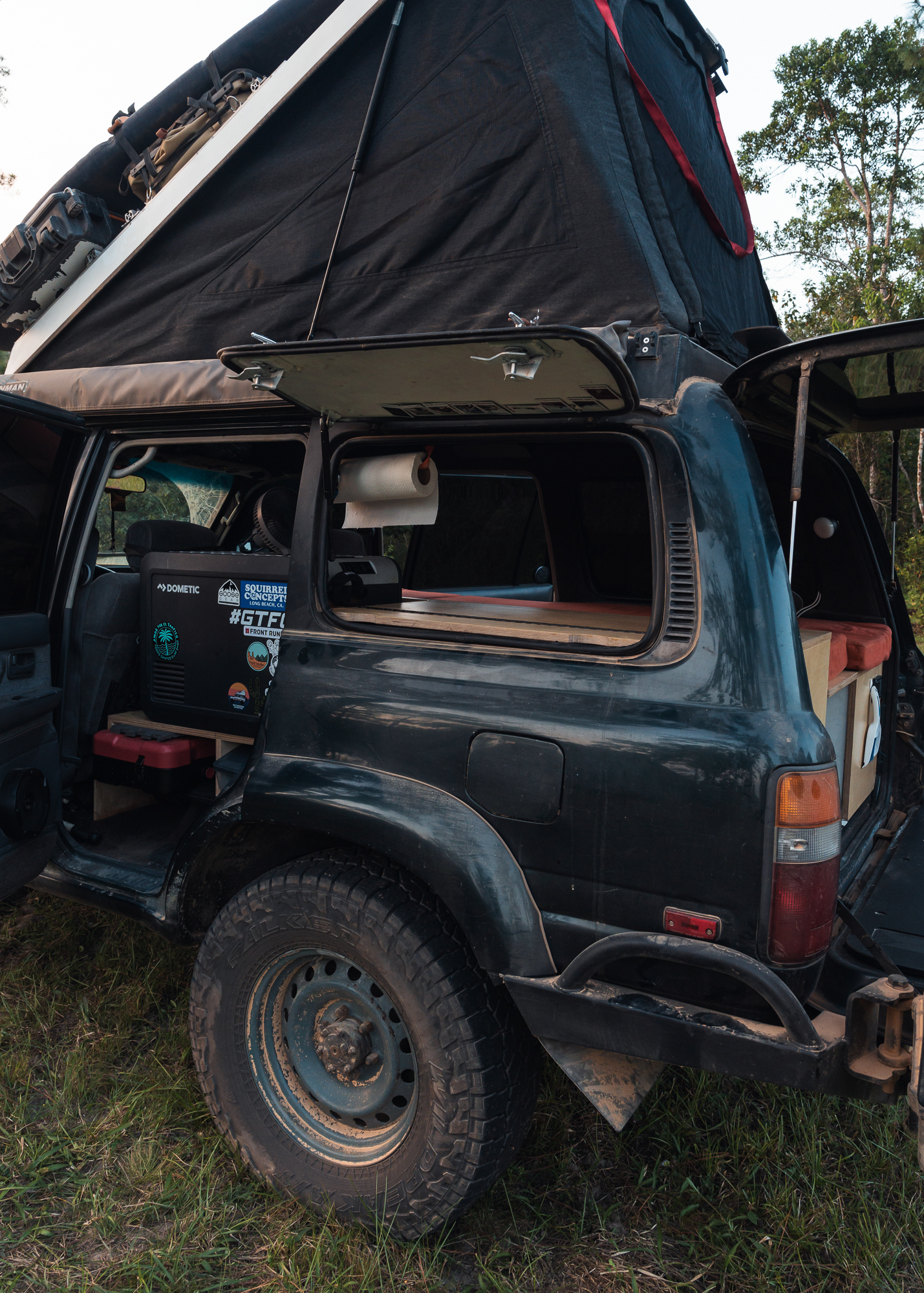
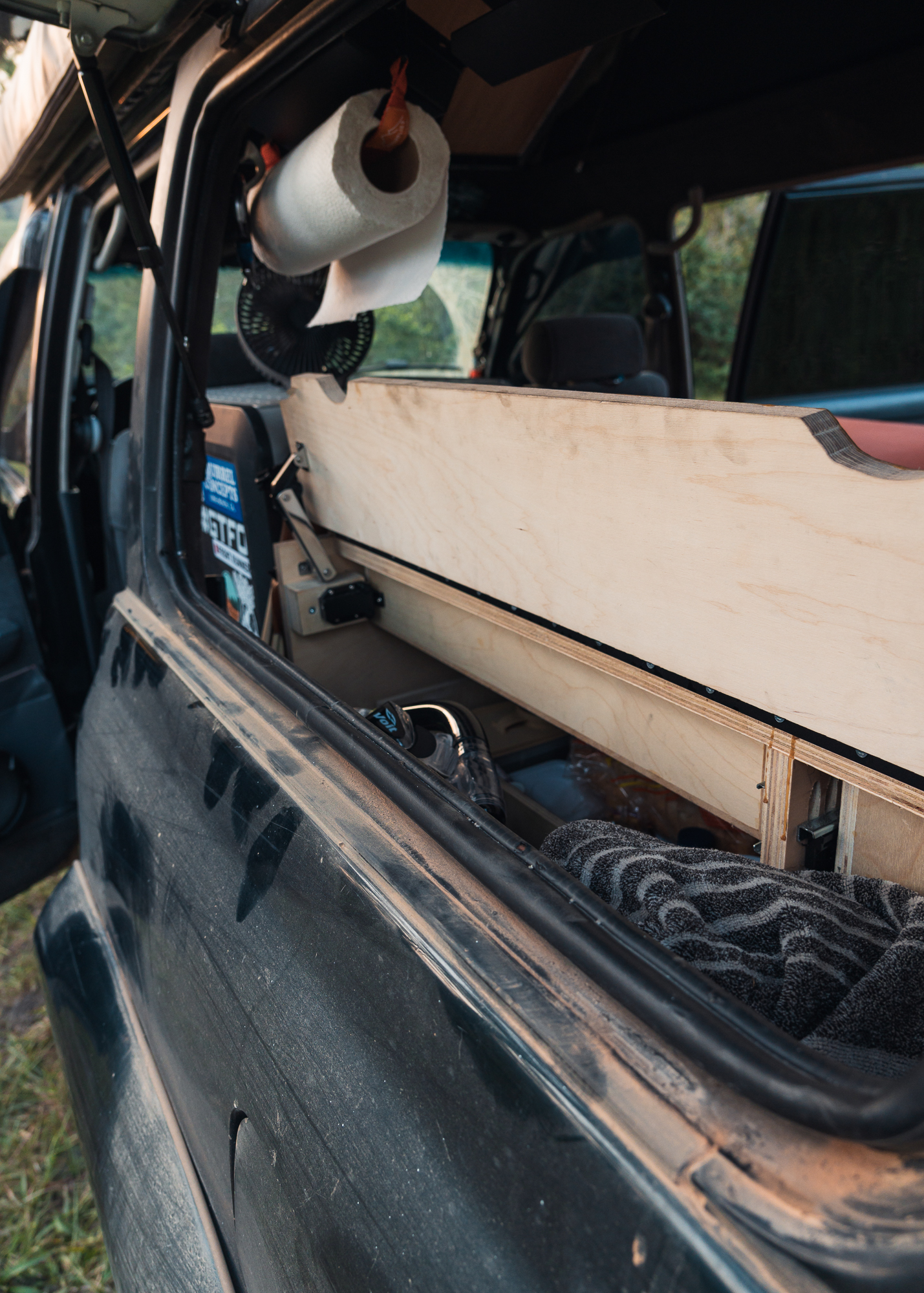
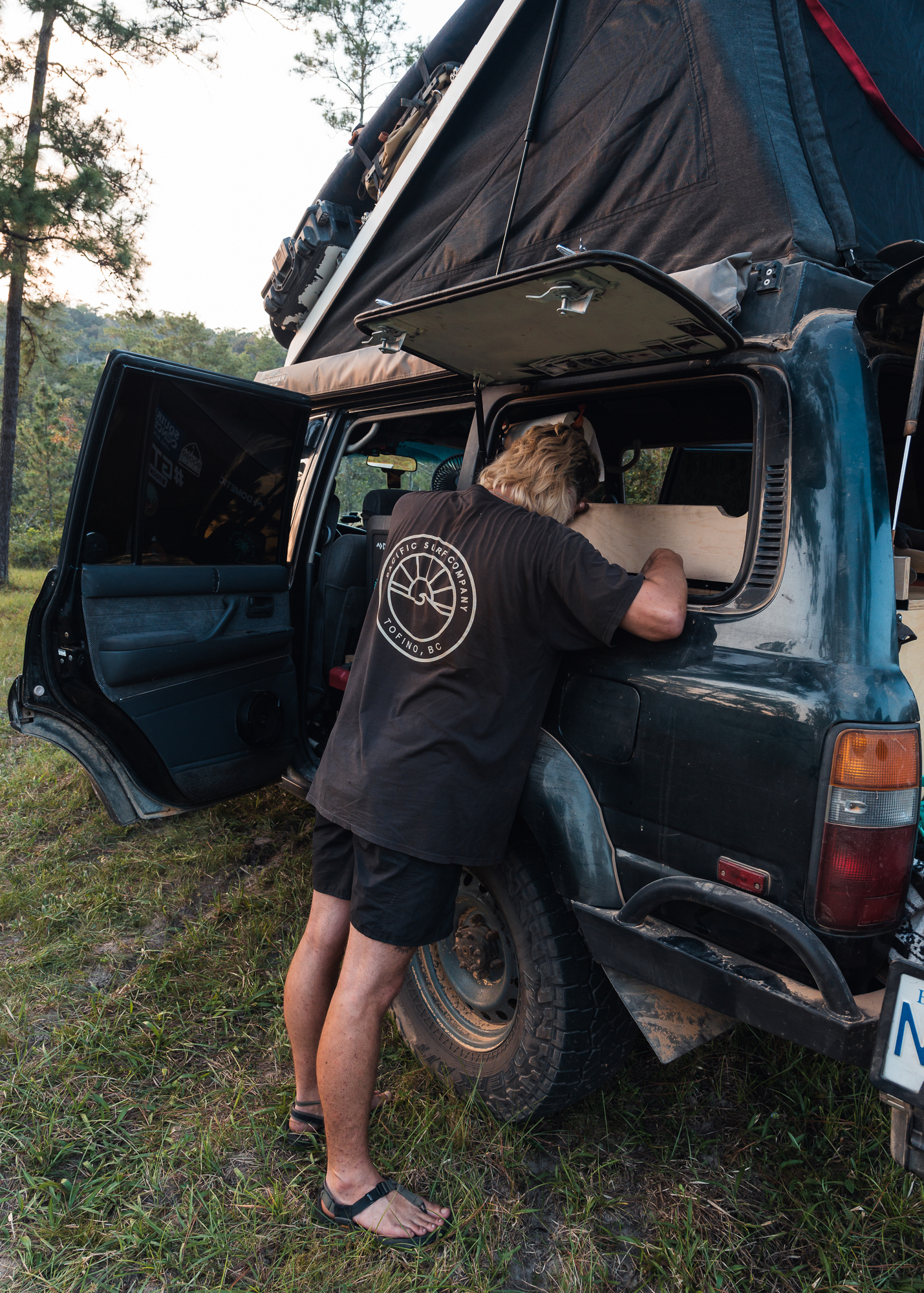
There is a smaller Pelican case mounted under our jerry cans to carry fluids like oil, brake fluid, and transmission fluid for the truck. As for tools, we have a little bit of everything: wrenches, ratchets, and sockets that fit every bolt that can be found on the Land Cruiser. Our tools also include a screwdriver, wire, bottle jack, hammer, hacksaw, and shovel. We have an ARB dual compressor under the hood and store most of our tools under the driver’s seat in a tool roll.
Recovery gear was one thing we wanted covered in case we got stuck or came across someone who needed help. We have a set of traction boards we store on our spare tire and a Warn VR Evo 8000 winch on the front bumper. We carry a tire repair kit, a full-size spare, a set of jumper cables, and a Noco jump box to cover our butts if we get stuck anywhere.”
Solar, Batteries, Inverter, Electronics
“Our goal was to have a simple electrical setup because we don’t consume much power. We have a Renogy 100Ah lithium battery, a Renogy 1,000-watt inverter, and two solar panels. Our 175-watt Renogy solar panels are mounted on the roof, and a Cascadia 4×4 90-watt panel is mounted on the hood. The system is also set up to be charged by the alternator as we drive. To save space, we planned to have our electrical system mounted in an open cavity of the rear quarter panel. In this spot, you will find all of our electrical systems tucked out of the way.”
Find Josh and Vanessa of Destined for Wild on YouTube and Instagram.
Our No Compromise Clause: We carefully screen all contributors to ensure they are independent and impartial. We never have and never will accept advertorial, and we do not allow advertising to influence our product or destination reviews.
Read more: Feature Vehicle Interior :: 4×4 Panda’s 1998 Puch 290 GD Mercedes G-Wagon


